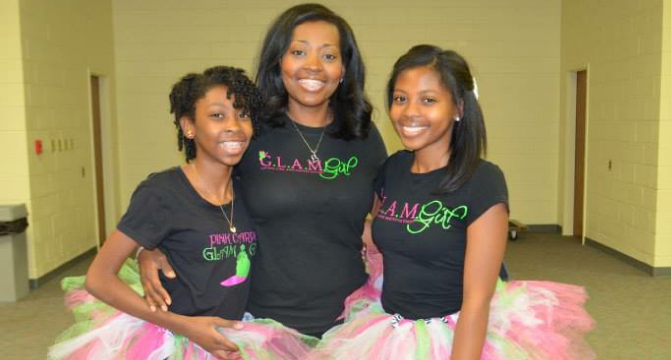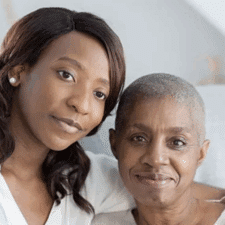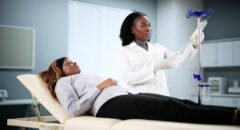
Two-time stroke survivor Tamika Quinn had to change her entire lifestyle to lose the excess weight that hung on following the birth of her third child, focusing on heart-healthy foods and keeping portion size in check.
Quinn, who lives in Chesapeake, Virginia, is getting some extra motivation these days thanks to Go Red Get Fit, a Facebook Group-based social media campaign by the American Heart Association designed to help women from diverse communities make health changes that become lifelong habits.
YOU MAY ALSO LIKE: High Blood Pressure: The Most Important Stroke Risk Factor You Can Control
The yearlong campaign, nationally sponsored by Macy’s, launched in March, challenging women to log at least 10,000 steps a day and limit added sugar to 24 grams a day. In June, participants were encouraged to add 30 minutes of cardio each day, at least five days a week, and choose water over sugary drinks 100 percent of the time.
Starting in September, participants will be challenged to build on previous health goals by getting more control over their sodium consumption. Their goal: eat no more than 1,500 milligrams a day.
On average, women age 20 and older in the U.S. consume 3,000 milligrams of sodium per day, twice as much as the upper limit recommended by the AHA for ideal heart health. Those figures are even higher for women in African-American, Asian and Hispanic communities.
Reducing the amount of salt in your diet is important to heart health because strong evidence has linked too much sodium to elevated blood pressure, which increases the risk of heart attacks, stroke, and kidney disease.
Quinn, 41, has already seen results from her efforts, shedding 6 pounds during the first quarter.
“I’m happy about that, I take pictures of my scale and post my results,” she said.
Quinn was 27 when she had two strokes. Although she came from a family with a history of high blood pressure, doctors advised her that the high blood pressure that appeared during her pregnancy would go away after her daughter was born. It didn’t.
Ten days later, Quinn went to the ER with a terrible headache and was diagnosed with a hemorrhagic stroke, or a stroke that occurs when a weakened blood vessel ruptures and bleeds into the surrounding brain. A second one followed a few days later and Quinn spent the next few months recovering her ability to walk and speak. She continues to deal with long- and short-term memory loss and muscle control.
Quinn worked to shed some of the weight she had gained, but took things more seriously after her then 8-year-old daughter Cashara was diagnosed with obesity and severe high cholesterol and referred to a pediatric cardiologist. The pair underwent nutrition classes at a local hospital and overhauled their lifestyle, changing their diet, cutting portion sizes and integrating more exercise.
The work paid off. Quinn went from a size 16 to a size 8. She still needs medication to manage her blood pressure, but her doctors have been able to eliminate two of the three medications because of her lifestyle changes.
Cashara also turned her health around.
“My daughter is in the best shape of her life,” she said. “She has totally transformed physically and instinctively makes great food choices.”
Quinn said Go Red Get Fit offers added inspiration as she tries to stay healthy.
“I know the value of my life, having almost lost it,” she said. “I want to go forward and live the best life I can.”
Quinn said the Go Red Get Fit campaign has helped her connect with new friends in her community for exercise classes and find inspiration from other participants across the country.
“I used to do videos at home, but the group really helps with accountability,” she said.
The community aspect of Go Red Get Fit provides a valuable support system for many women, said Alice Benjamin, a registered nurse who works as a cardiac clinical nurse specialist in Los Angeles and is known as Nurse Alice.
“Sometimes you’re the only person in your social group who wants to eat healthy and exercise and because of culture or peer group, we sometimes mute our drive to get healthier,” said Nurse Alice, who chairs AHA’s multicultural health task force for the Western states. “Go Red Get Fit provides an online community where you can reach out and hear other success stories and get ideas from women just like you.”
Nurse Alice said the access to experts provides an important forum for information.
“As a nurse, when a patient’s in the hospital, there’s always so much going on that its not always the best time for someone to receive information,” she said. “This campaign lets them get information from the comfort of their home or wherever they want, 24 hours a day, when they are ready to receive it.”
Nurse Alice said Go Red Get Fit challenges offer women easy ways to fit in exercise wherever they are and no matter what their schedule.
“Lots of people say, ‘I don’t have 30 minutes to exercise,’” she said. “If that’s the case, get 10 minutes in three times during the day. Eat your lunch, but then spend 10 minutes walking around your building, or do some squats at your desk during a break.”
Encouraging participants to choose water is also important for reducing added calories and extra sugar.
“I love a good Starbucks too, but too often, we’re just mindlessly consuming calories without realizing it,” Nurse Alice said. “The healthiest option is water.”
Quinn said she notices a big difference in her health when she chooses water.
“You just feel awake and alive when you drink enough water,” she said.








